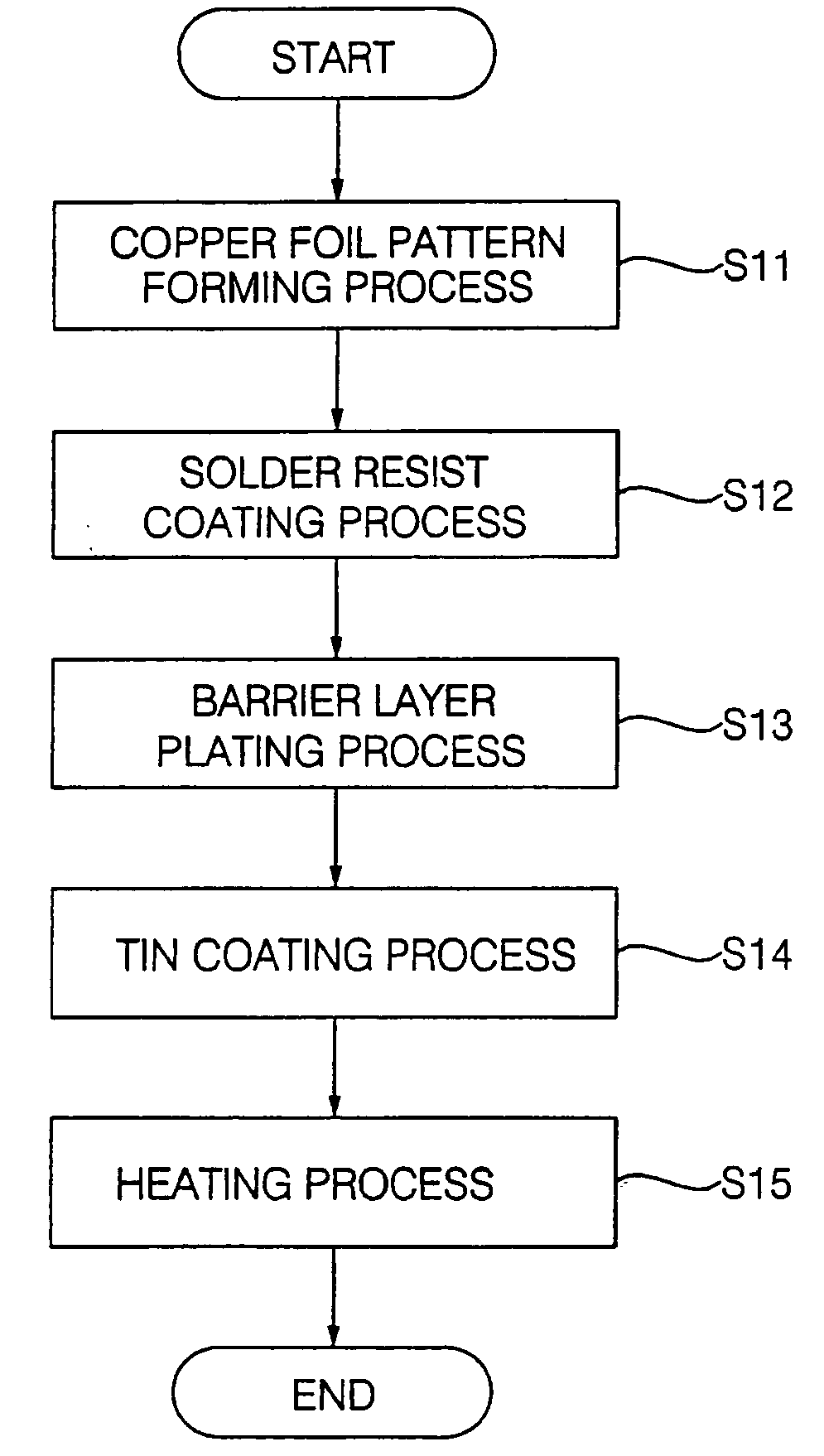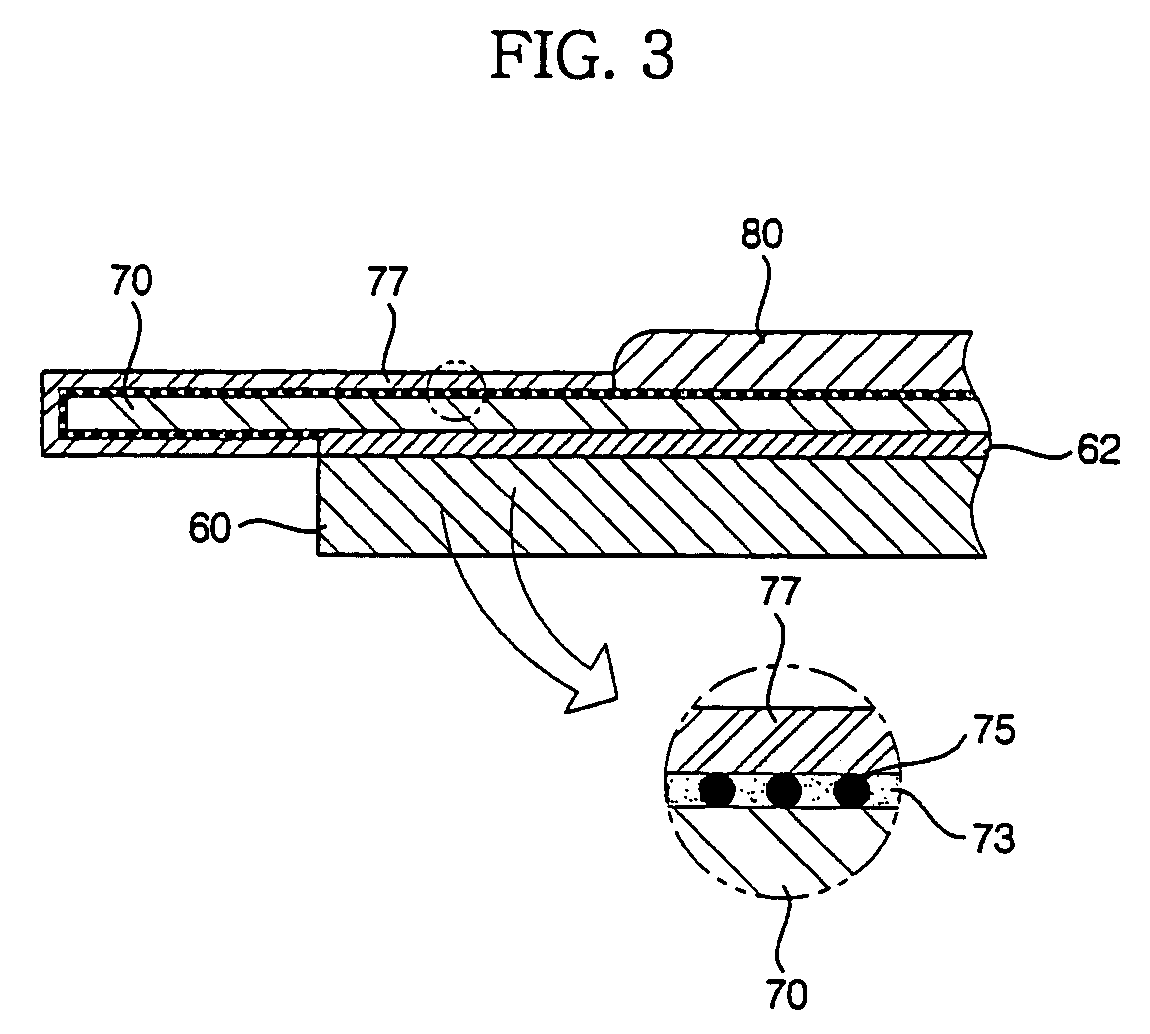Tape substrate and method for fabricating the same
- Summary
- Abstract
- Description
- Claims
- Application Information
AI Technical Summary
Benefits of technology
Problems solved by technology
Method used
Image
Examples
example 1
[0068] A copper foil pattern having a thickness of 18 μm was formed on a polyimide film. Thereafter, a barrier layer having a thickness of 0.1 μm was formed over the entire upper surface of the copper foil pattern. Subsequently, a solder resist was printed to a thickness of 30 μm over the barrier layer, and then thermally set at a temperature of 150° C. for 60 minutes. A tin layer was then formed over the barrier layer in a tin plating bath maintained at 65° C. In accordance with these processes, tape substrates having different tin layer thicknesses of 0.2 μm, 0.3 μm, and 0.4 μm, respectively, were fabricated. Any of the tape substrates did not exhibit voids and whiskers at the boundary of the solder resist. Even after being aged for seven days, any of the tape substrates did not exhibit whiskers even after being aged for seven days.
example 2
[0069] A copper foil pattern having a thickness of 18 μm was formed on a polyimide film. Thereafter, a solder resist was printed to a thickness of 30 μm on the upper surface of the copper foil pattern at a region other than a connecting area, and then thermally set at a temperature of 150° C. for 60 minutes. Thereafter, a barrier layer having a thickness of 0.1 μm was formed on the copper foil pattern. A tin layer was then formed over the barrier layer in a tin plating bath maintained at 65° C. In accordance with these processes, tape substrates having different tin layer thicknesses of 0.1 μm, 0.2 μm, and 0.3 μm, respectively, were fabricated. Any of the tape substrates did not exhibit voids and whiskers at the boundary of the solder resist. Even after being aged for seven days, any of the tape substrates did not exhibit whiskers.
example 3
[0070] A copper foil pattern having a thickness of 18 μm was formed on a polyimide film. Thereafter, a solder resist was printed to a thickness of 30 μm on the upper surface of the copper foil pattern at a region other than a connecting area, and then thermally set at a temperature of 150° C. for 60 minutes. Thereafter, a barrier layer having a thickness of 0.1 μm was formed on the copper foil pattern. A tin layer was then formed over the barrier layer in a tin plating bath maintained at 65° C. In accordance with these processes, tape substrates having different tin layer thicknesses of 0.2 μm, 0.3 μm, and 0.4 μm, respectively, were fabricated. After the formation thereof, the tin layer was dried at a temperature of 120° C. for 120 minutes. All tape substrates exhibited excellent characteristics.
PUM
| Property | Measurement | Unit |
|---|---|---|
| Thickness | aaaaa | aaaaa |
| Stress optical coefficient | aaaaa | aaaaa |
Abstract
Description
Claims
Application Information
 Login to View More
Login to View More - R&D
- Intellectual Property
- Life Sciences
- Materials
- Tech Scout
- Unparalleled Data Quality
- Higher Quality Content
- 60% Fewer Hallucinations
Browse by: Latest US Patents, China's latest patents, Technical Efficacy Thesaurus, Application Domain, Technology Topic, Popular Technical Reports.
© 2025 PatSnap. All rights reserved.Legal|Privacy policy|Modern Slavery Act Transparency Statement|Sitemap|About US| Contact US: help@patsnap.com



